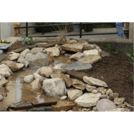
Students will observe and describe the physical properties of water by exploring water at different stations
- Subject:
- Physical Science
- Material Type:
- Lesson Plan
- Author:
- Out Teach
- Date Added:
- 07/22/2021

Students will observe and describe the physical properties of water by exploring water at different stations
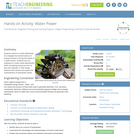
Students observe a model waterwheel to investigate the transformations of energy involved in turning the blades of a hydro-turbine. Students work as engineers to create model waterwheels while considering resources such as time and materials, in their design. Students also discuss and explore the characteristics of hydropower plants.
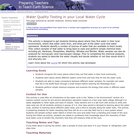
Students analyze local water chemistry by identifying and collecting local water samples, deciding upon questions they want to answer about their local water sources, and then performing simple water quality tests on their samples.
(Note: this resource was added to OER Commons as part of a batch upload of over 2,200 records. If you notice an issue with the quality of the metadata, please let us know by using the 'report' button and we will flag it for consideration.)
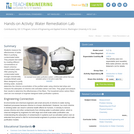
Students measure the effectiveness of water filters in purifying contaminated water. They prepare test water by creating different concentrations of bleach (chlorine-contaminated) water. After passing the contaminated water through commercially available Brita® water filters designed to purify drinking water, students determine the chlorine concentration of the purified water using chlorine test strips and measure the adsorption of chlorine onto activated carbon over time. They graph and analyze their results to determine the effectiveness of the filters. The household active carbon filters used are one example of engineer-designed water purification systems.
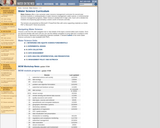
Water Science offers a two-semester water resource management curriculum for second year technical students or undergraduates in water resource management, water science, or environmental resource management programs. Water Science is divided into 6 major units. Each unit is divided into modules encompassing approximately a week's worth of lectures and labs.
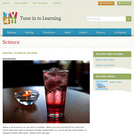
Water is all around us in one form or another. When you cool yourself off on a hot and humid afternoon with a tall glass of water loaded with ice, you’ve got the three states, or phases of water right there—liquid, solid, and gas.
In this lesson you will:
Identify the three states, or phases, of matter: solid, liquid, and gas
Explore how water changes from one phase to another
Examine arrangement and movement of water molecules in each phase of matter
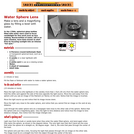
In this activity about light and refraction, learners make a lens and magnifying glass by filling a bowl with water. Learners explore why the lens inverts images and also reverses the motion of images. Use this activity to introduce learners to basic principles of light and lenses. Activity includes light-ray diagram to explain how image is formed.

In this video segment adapted from ZOOM, visit a water treatment plant and learn how water from a local reservoir is turned into drinking water.
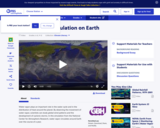
This simulation from the National Center for Atmospheric Research portrays annual patterns in water vapor and precipitation across the globe, illustrating general circulation patterns as well as seasonal and regional variation.
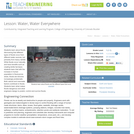
Students learn about floods, discovering that different types of floods occur from different water sources, but primarily from heavy rainfall. While floods occur naturally and have benefits such as creating fertile farmland, students learn that with the increase in human population in flood-prone areas, floods are become increasingly problematic. Both natural and manmade factors contribute to floods. Students learn what makes floods dangerous and what engineers design to predict, control and survive floods.

Water has served and sustained societies throughout history. Understanding the complex and diverse water systems of the past is key to devising sustainable development for the future with regard to socioeconomic structures, policies, and cultures. Today, past systems form the framework for preservation and reuse as well as for new proposals.
In this course, you will learn how to identify the spatial, social and cultural aspects of water heritage in your environment. You will investigate real situations, assess specific issues and evaluate the impact of potential measures, following existing expertise on water heritage and water management traditions as a model for your own practice.
By examining examples of water heritage from around the world, and by interacting with fellow learners, you will learn to implement globally sustainable approaches and tools such as the UNESCO Historic Urban Landscape (HUL) and the UN Sustainable Development Goals (SDGs).
Completing this course would be of great benefit to:
- professionals working in water management (such as water boards, water districts or port authorities etc.), heritage, or planning processes that include water related issues;
- master students of urban planning, architecture, heritage, or landscape;
- anyone living in a city or rural area where water management issues occur and with an interest in improving their living environment.
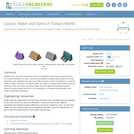
Students learn about the importance of dams by watching a video that presents historical and current information on dams, as well as descriptions of global water resources and the hydrologic cycle. Students also learn about different types of dams, all designed to resist the forces on dams. (If the free, 15-minute "Water and Dams in Today's World" video cannot be obtained in time, the lesson can still be taught. See the Additional Multimedia Support section for how to obtain the DVD or VHS videotape, or a PowerPoint presentation with similar content [also attached].)
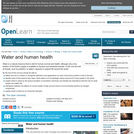
Water is a natural resource that is vital for human survival and health, although only a tiny fraction of the Earth's supply is available to humans and terrestrial animals. In this unit we look at threats, such as pollution, to water's capacity to support life around the world.
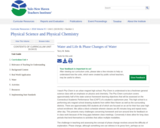
“Water and Life & Phase Changes of Water” is a unit that can be used to cover the Connecticut high school science content requirements concerning: phase changes of matter. The concept of phase change must be approached just as that, a concept. Encouraging students to develop a conceptual understanding of phase change is a focus of this unit. If the teaching of phase change is approached as such with the end goal of students connecting phase change with energy, molecular movement, and intermolecular bonds students can develop a deep understanding of the concept and be better prepared to apply this understanding to multiple situations.
This unit also addresses the need for strong content to be partnered with the very conceptual phase changes of water. A section on the emergent properties of water is included. These properties are fundamental to life on this planet, an inherently interesting topic for students. The emergent properties, all due to the polarity of the water molecule, are: expansion upon freezing; usefulness as a solvent; high specific heat; and cohesive behavior. Examples to use in the classroom are provided to the reader as well. The backdrop of life sciences can help a high school teacher make more connections between physical sciences and students’ lives.
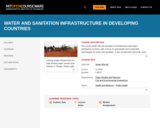
This course deals with the principles of infrastructure planning in developing countries, with a focus on appropriate and sustainable technologies for water and sanitation. It also incorporates technical, socio-cultural, public health, and economic factors into the planning and design of water and sanitation systems. Upon completion, students will be able to plan simple, yet reliable, water supply and sanitation systems for developing countries that are compatible with local customs and available human and material resources. Graduate and upper division students from any department who are interested in international development at the grassroots level are encouraged to participate in this interdisciplinary subject.
Acknowledgment
This course was jointly developed by Earthea Nance and Susan Murcott in Spring 2006.

Water as a solvent. Polar solutes. Hydrophilic and hydrophobic substances.

WOW lessons are designed for infusion into the existing science curriculums for college freshmen and advanced high school students. The lessons use the aquatic environment and real lake data to explore basic science concepts through two different approaches: a directed study “Studying” and an inquiry “Investigating” approach. The directed studies allow students to apply and learn concepts through direct, guided experience. The inquiry lessons provide a more open-ended opportunity for students to discover the same concepts.
Each teacher's lesson plan provides general direction for guiding students to understand the topic through the directed study and the inquiry approach. Student lessons are organized into a thinking framework of six sequential components that are critical for improving scientific and technological literacy: knowledge base, experimental design, data collection, data management and analysis, interpretation of results, and reporting results. The teacher lesson plans follow the same format.
Lesson titles are simple and descriptive so that you may easily find useful materials. We recommend you begin by reviewing the student lessons that may be appropriate for your class. When you've found a student lesson to use, return to the menu below to review the associated teacher's lesson plan. There are tutorials to help you and your students get familiar with the site, they may be accessed from the menu below, or at the top of any 'teacher' page.
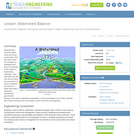
Students learn about the water cycle and its key components. First, they learn about the concept of a watershed and why it is important in the context of engineering hydrology. Then they learn how we can use the theory of conservation of mass to estimate the amount of water that enters a watershed (precipitation, groundwater flowing in) and exits a watershed (evaporation, runoff, groundwater out). Finally, students learn about runoff and how we visualize runoff in the form of hydrographs.
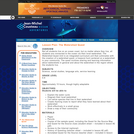
Not all students live on an ocean coast, but no matter where they live, all students are connected to the ocean via their local watershed. The Watershed Quest Unit is an integrated-curriculum unit that culminates with the creation of a watershed quest, a treasure hunt centered on a watershed in your community. The quest involves sharing and learning information about watersheds in general and about the watershed in the region where the students live.
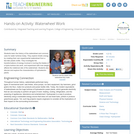
Students learn the history of the waterwheel and common uses for water turbines today. They explore kinetic energy by creating their own experimental waterwheel from a two-liter plastic bottle. They investigate the transformations of energy involved in turning the blades of a hydro-turbine into work, and experiment with how weight affects the rotational rate of the waterwheel. Students also discuss and explore the characteristics of hydroelectric plants.